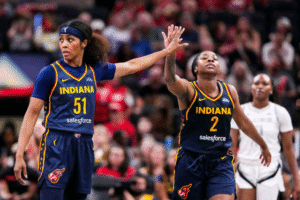
The Indiana Fever endured a devastating setback on Friday, learning that two of their key backcourt contributors — Sydney Colson and Aari McDonald — will not return to the court for the rest of the season. Both players sustained significant injuries during Thursday night’s lopsided 95–60 defeat to the Phoenix Mercury, a game that not only dented Indiana’s momentum but also left the team scrambling to address sudden roster gaps. Following medical evaluations, the organization officially confirmed that each player’s injury is severe enough to sideline them for the remainder of the current campaign.

A Double Blow in One Night
Thursday’s matchup against Phoenix was difficult from start to finish for the Fever. They struggled offensively, failed to contain the Mercury’s attack, and ultimately absorbed a heavy 35-point loss. Yet, the scoreboard was not the most painful part of the evening — the bigger heartbreak came from watching two teammates leave the floor with injuries that, as it turned out, would end their seasons.
Sydney Colson’s injury was the first and arguably the most gut-wrenching moment of the night. It occurred without any physical contact from an opposing player, happening right in front of the Fever bench. The 34-year-old veteran guard crumpled to the hardwood in visible pain, clutching her knee as her teammates and coaches rushed to check on her. The arena fell quiet, with fans and players alike sensing that the moment was serious.
Later in the game, near its conclusion, Aari McDonald also went down. She had to be assisted off the floor and helped into the locker room. While the team initially withheld specifics, further evaluation revealed a fracture in her right foot, an injury that would prevent her from suiting up again this year. The fact that these incidents unfolded in the same contest compounded the emotional weight for the Fever.
Coach Stephanie White Responds to Colson’s Injury
After the game, Indiana head coach Stephanie White addressed the media. Although the official diagnosis for Colson had not yet been released at that time, White’s tone reflected the gravity of the situation. She explained that the injury had rattled the team emotionally as well as affected them strategically.
“It affects us emotionally, because nobody wants to see a teammate go down like that,” White said during her postgame remarks. “But also, on the floor, that’s another point guard, a primary ball handler, someone who is a big part of our rotation on both ends of the floor.”
At the time, White was speaking with the hope — however slim — that the injury might not be season-ending. However, less than 24 hours later, the team confirmed the worst: Colson had suffered a torn ACL, ending her season immediately. The injury not only removes one of Indiana’s more experienced and steadying presences from the lineup but also eliminates an important on-court leader in managing game tempo and defensive communication.
Sydney Colson’s Role and Impact
Colson’s value to the Fever went beyond her statistics. As a veteran with multiple seasons of WNBA experience, she brought leadership, composure, and a calm hand in tense situations. She often acted as a stabilizer for the offense, particularly when the team needed to control the pace or execute set plays against aggressive defenses. Losing her means losing a trusted decision-maker who could organize the team in transition and orchestrate possessions in the half-court.
Defensively, Colson’s quickness and ability to read opponents’ schemes allowed her to disrupt passing lanes and pressure ball handlers. Her absence forces the Fever to rethink their defensive assignments and rotations, as well as their offensive flow. Given that Indiana had already been operating without Caitlin Clark — the reigning Rookie of the Year and their primary offensive catalyst — the loss of Colson is a serious blow to both their tactical plans and their locker room chemistry.
Aari McDonald’s Setback
If losing Colson was devastating, losing McDonald in the same game compounded the crisis. The 5-foot-6 guard had only joined the Fever in June on a season-long contract, but she quickly carved out a role in the rotation. McDonald became particularly important after Clark went down with a groin injury earlier in the season, stepping up to shoulder more of the backcourt responsibilities.
McDonald’s style of play — fast, aggressive, and unafraid to attack the basket — had given Indiana a needed spark at times. Her ability to break down defenses off the dribble and apply constant ball pressure on the other end made her a useful weapon for Coach White. The fractured bone in her right foot, however, ends her season prematurely and removes yet another capable ball handler from the Fever’s already thin guard lineup.
Timing Could Not Be Worse
The timing of these injuries could hardly be more challenging for Indiana. The Fever have been trying to steady themselves after a turbulent start to the season, managing to win five of their previous seven games before hitting a recent skid with consecutive losses to the Los Angeles Sparks and the Mercury. Their push to stay competitive in the standings was already complicated by Clark’s indefinite absence, and now they face the reality of entering upcoming games without any of their top three point guard options.
Clark’s recovery remains a question mark. The team has not provided a timeline for her return, sticking to the stance that she will be given as much time as needed to heal fully. That cautious approach is sensible for protecting a franchise player, but it leaves the Fever with a glaring gap in playmaking.
Emergency Roster Decisions Ahead
With both Colson and McDonald sidelined for the year and Clark still out, Indiana currently does not have a healthy natural point guard available for their next game — a rivalry matchup with the Chicago Sky scheduled for Saturday. Under WNBA rules, the team can now apply for an emergency hardship waiver, which would allow them to sign another player to fill the immediate void in the backcourt.
The hardship waiver exists for precisely these kinds of scenarios, where injuries deplete a roster beyond standard depth and leave a team unable to field a competitive lineup at certain positions. The Fever’s front office will likely move quickly to identify a candidate who can step in, even if only as a short-term solution.
The Emotional Toll on the Team
The loss of two teammates in one night carries an emotional weight that goes beyond X’s and O’s. Injuries, especially season-ending ones, have a psychological effect on a team. Players spend months training, competing, and bonding, and when a colleague’s season abruptly ends, it serves as a stark reminder of the fragility of professional sports careers.
Coach White’s remarks captured the mix of concern and practical challenge that comes with such events. She acknowledged the personal impact — the empathy and worry for the injured players — while also noting the difficult adjustments the team must now make. Balancing those realities will be key in how the Fever respond in the coming weeks.
Looking Ahead Without Their Guards
Strategically, Indiana must now adapt its offensive schemes. Without a true point guard, the role of initiating offense may fall to combo guards or even forwards who have some ball-handling skills. This will likely mean more responsibilities for players who are not accustomed to being primary facilitators, which could lead to growing pains and turnovers until the team settles into a new rhythm.
Defensively, rotations may need to be altered to cover for the absence of quick perimeter defenders like Colson and McDonald. The Fever may experiment with different matchups or shift toward zone schemes to mitigate the impact of slower ball-handlers being pressed by opponents.
The Challenge of Depth in the WNBA
The situation also highlights the challenges of depth in the WNBA, where rosters are small and injuries can have an outsized effect. With only 12 roster spots available per team, losing two players at the same position can create an immediate crisis. Teams cannot simply pull from a deep bench of replacements; every addition requires careful roster and salary cap considerations.
The Fever’s path forward will involve balancing the short-term need for backcourt help with the long-term goals of building a competitive roster. Signing a temporary guard under the hardship exemption might solve the immediate game-day problem, but it is unlikely to replace the chemistry and experience that Colson and McDonald brought.
Conclusion: A Pivotal Moment in the Fever’s Season
The back-to-back losses to Los Angeles and Phoenix already put Indiana in a position where they needed to regroup. Now, with Sydney Colson and Aari McDonald officially done for the year and Caitlin Clark still sidelined, the team faces perhaps its most difficult stretch of the season. Their response — in terms of both roster moves and on-court adaptation — will determine whether they can stay competitive in the playoff race or slip further down the standings.
For now, the Fever are left to rally around the healthy players they have, lean on the resilience that has carried them through earlier challenges, and hope that their forthcoming roster adjustments can stabilize the team in time for the crucial games ahead. The coming weeks will test their depth, their adaptability, and their collective spirit.
Leave a Reply